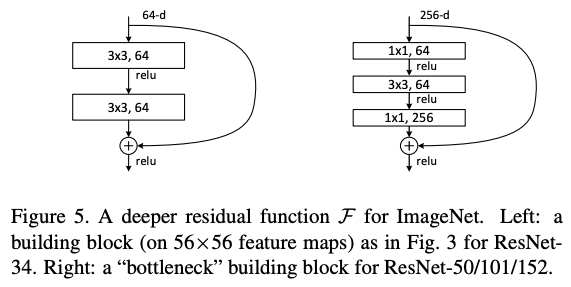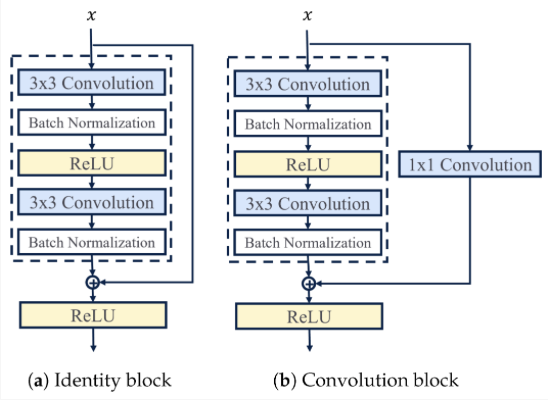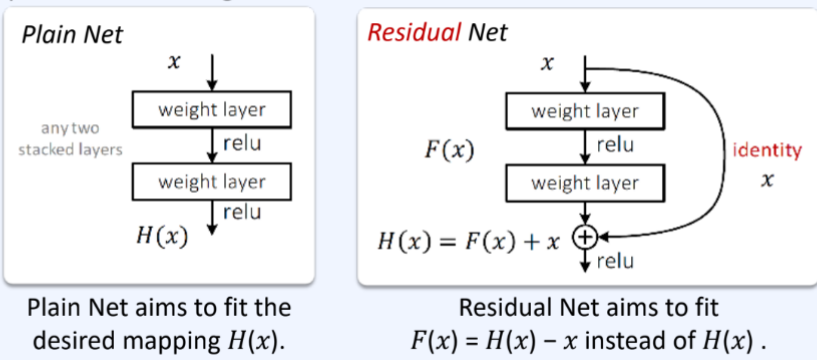ResNet: Deep Residual Learning for Image Recognition (2015)¶
ref. : ori. Deep Residual Learning for Image Recognition
ILSVRC 2015년 우승 모델 (deep learning의 deep의 개념을 바꿈.)
- Kaiming He, Xiangyu Zhang, Shaoqing Ren, Jian Sun
- top-5 error가 3.6% 이하.
- 152 layers라는 당시로는 매우 놀라운 깊이의 deep model임.
ResNet은 skip connection (= short connection)을 도입하여 매우 깊은 모델의 학습을 가능하게 함.
- ResNet의 경우 identity 와 addition을 이용하는
skip connection을 사용하여residual learning을 수행함. - 최근에는 addition 연산 기반의
residual learning대신에concatenation을 이용한skip connection도 많이 사용됨.
residual learning의 경우skip connection의 결과를 add를 이용하여 연결함.
concatenation은 그냥 feature map이 추가(문자열의 concatenation과 유사)되는 형태 (channel이 많아짐)가 됨.
concatenation기반의 연결은DenseNet (2017)을 통해 유용성을 보임.
구조¶
전반적인 구조는
- 매우 많은 수의 convolutional layers (엄밀하게 애기하면
residual unit (RU))가 반복되어 구성됨.RU는 보통 2개의 convolutional layers로 구성됨.- 첫번재 convolutional layer는 이후 BN과 ReLU로 이어짐.
- 이후 두번째 convolutional layer로 이어지고 이 결과는 BN을 거침.
- 이 결과는 skip connection 으로 넘겨지는 input과 addition이 수행되고, 해당 결과는 ReLU를 거침.
RU사이에 main path 로 연결되고,RU의 input과 output은 skip connection을 통해 연결되어 추가적인 path가 존재하는 구조 .

- 각 convolutional layers 의 activation function은
ReLU임. - 파선으로 그려진 skip connection 의 경우, 논문에서 zero-padding shortcuts와 projection shortcuts 의 두가지로 구현하여 비교함.
- projection shortcuts가 좀더 우수한 결과를 보임.
- channel이 2배 늘어나는 경우에는 feature map의 width와 height가 ½ 로 줄어듬 (pooling을 사용하지 않고, stride=2로 사용)
- 일반적으로 같은 channel 수의
RU가 연결된 경우에는 stride=1이지만, 달라지는 경우 stride=2를 사용함.
ResNet은 convolutional layer 와 fully-connected layer 만을 count(즉, trainable layer만 count)하여,
18개의 layers를 가지는 ResNet-18부터 152개의 layers를 가지는 ResNet-152까지
당시로서는 매우 깊은 구조의 CNN을 제안함.
ResNet-34: * Conv (64ch) - RU (64ch) \(\times 3\) - RU (128ch) \(\times 4\) - RU (256ch) \(\times 6\) - RU (512ch) \(\times 3\) - FC (1000ch)
ResNet-152: * Conv (64ch) - Bottleneck RU (256ch) \(\times 3\) - Bottleneck RU (512ch) \(\times 8\) - Bottleneck RU (1024ch) \(\times 36\) - Bottleneck RU (2048ch) \(\times 3\) - FC (1000ch)
Residual Block¶
다음은 ResNet 18/34 에서 사용된 기본 RU와 그보다 더 깊은 ResNet에서 사용된 Bottleneck RU의 구성임.

- 오른쪽의
Bottleneck BN은, ResNet 50/101/152 에서 사용됨.
다음은 Bottleneck BN 에서 identity shortcut과 projection shortcut을 보여준다.

Residual Learning¶
실제로 hypothesis \(h(\textbf{x})\)를 구하는 기존 모델(아래 그림에서 plain net)과 달리
ResNet은 hypothesis와 input \(\textbf{x}\)간의 차이인 residual \(f(\textbf{x})=h(\textbf{x})-\textbf{x}\) 를
구하는 residual learning을 채택함.

- skip connection을 통해 \(f(\textbf{x})\)에 \(\textbf{x}\)가 더해주는 구조로 \(h(\textbf{x})\)를 구하게 됨.
- \(f(\textbf{x})\)가 \(h(\textbf{x})\)보다 구하기 쉬움.
torchvision¶
import torchvision
pretrained = True
# A lot of choices :P
model = torchvision.models.resnet18(pretrained)
model = torchvision.models.resnet34(pretrained)
model = torchvision.models.resnet50(pretrained)
model = torchvision.models.resnet101(pretrained)
model = torchvision.models.resnet152(pretrained)
model = torchvision.models.wide_resnet50_2(pretrained)
model = torchvision.models.wide_resnet101_2(pretrained)